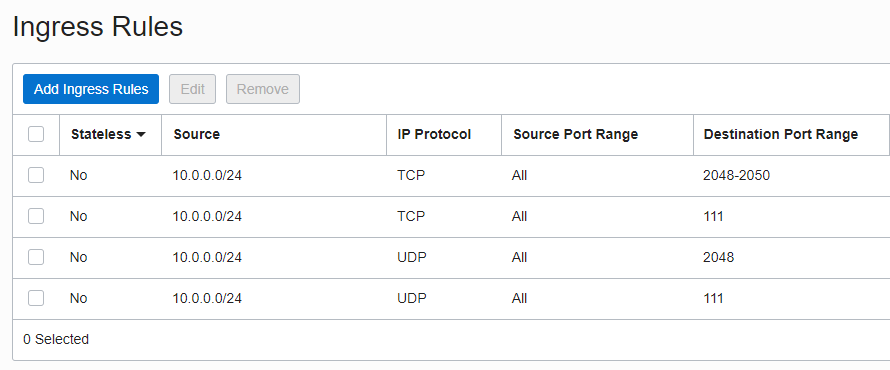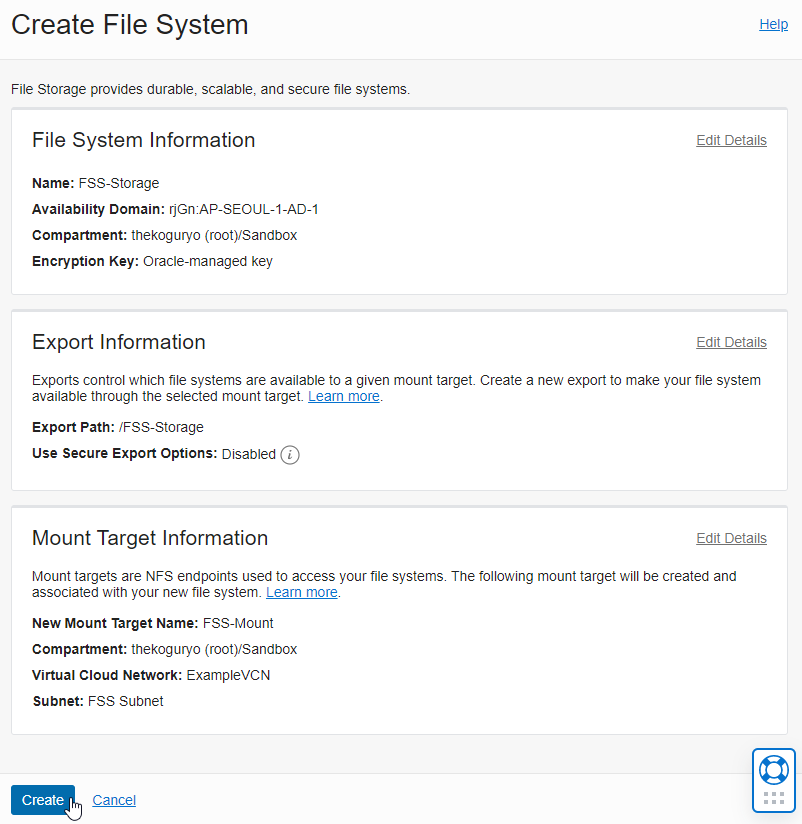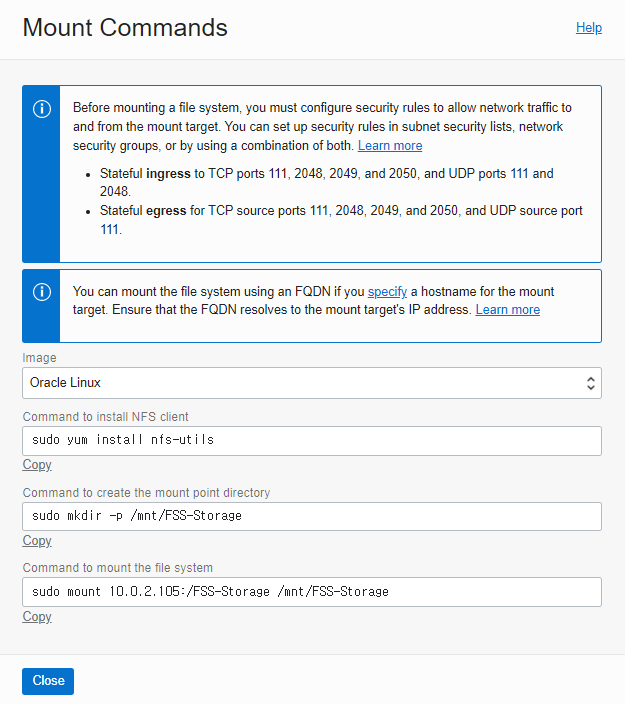Warning
This content has been generated by machine translation. The translations are automated and have not undergone human review or validation.
8.2 Mounting and using FSS (File Storage Service) on a Linux VM
Constraints
Create Subnet
Open the navigation menu in the OCI console. Go to Networking > Virtual Cloud Networks.
Click on ExampleVCN, the VCN you created earlier.
Click Create Subnets
Enter creation information: Enter only bold text fields and use default values for the rest.
- Name: Enter a name, FSS Subnet
- Subnet Type: Select the default REGIONAL
- REGIONAL: This is a subnet that is globally located in the region, and has the advantage of being able to use the IP as it is in case of a Failover to another AD.
- AVAILABILITY DOMAIN-SPECIFIC: Subnet created in AD
- CIDR Block: 10.0.2.0/24
- Route Table: Select Default Route Table
- Subnet Access: Select Public Subnet
- DHCP Options: Select Default DHCP Options
Scroll to the bottom and click Create Subnet
FSS Subnet creation complete

Create a Security List for File Storage Service
In order to use File Storage Service on FFS Subnet (10.0.2.0/24) from VM on ExampleVCN’s Public Subnet (10.0.0.0/24), the relevant port needs to be opened. Let’s create a Security List for this.
Left click Resources > Security Lists
Click Create Security List
Enter creation information
Name: Enter a name, FSS Security List
Allow Rules for Ingress: Enter as below table to open as VM target on Public Subnet (10.0.0.0/24)
Stateless Source IP Protocol Source Port Range Destination Port Range No 10.0.0.0/24 TCP All 2048-2050 No 10.0.0.0/24 TCP All 111 No 10.0.0.0/24 UDP All 2048 No 10.0.0.0/24 UDP All 111
Creation complete

Apply Security List to Subnet
Go to the detail page of the FSS Subnet you created earlier.
Add the FSS Security you just created to the Security List of the FSS Subnet.

Create File System
Open the navigation menu in the OCI console. Go to Storage > File Storage > File Systems.
Click Create File System
Enter creation information
You can use the default, but change the name for convenience.
File System Information
- Name: Click Edit Details on the right to change the name to the desired name, enter FSS-Storage
Export Information : Use default value
Mount Target Information
- New Mount Target Name: Click Edit Details on the right to change the name to the desired name, enter FSS-Mount
- Virtual Cloud Network: ExampleVCN
- Subnet: FSS Subnet, select the subnet created for File Storage created earlier

Mount File System
Click Action Menu on the right side of Export at the bottom of the created File System and click Mount Commands.

Check the commands required to mount the FSS on the client.
Select the OS from the image. The figure below is based on Oracle Linux.

Connect to the Compute Instance on the Public Subnet (10.0.0.0/24) of ExampleVCN created in the previous exercise.
Execute the Mount Commands you checked in the OCI console in order.
Command example
# Install NFS client sudo yum install nfs-utils # create mount folder sudo mkdir -p /mnt/FSS-Storage # mount sudo mount 10.0.2.105:/FSS-Storage /mnt/FSS-StorageResult check and test
# Check the mount result df -h # change permissions sudo chmod 777 /mnt/FSS-Storage # Confirm file creation echo 'Hello File Storage' > /mnt/FSS-Storage/hello1.txt ls -la /mnt/FSS-Storage/
Example Results
ubuntu@NOTEBOOK-WORK:~/.ssh$ ssh -i mysshkey opc@152.67.220.47 Last login: Fri Jan 14 01:57:59 2022 from 223.62.21.154 [opc@examplelinuxinstance ~]$ # Install NFS client [opc@examplelinuxinstance ~]$ sudo yum install nfs-utils Loaded plugins: langpacks, ulninfo Package 1:nfs-utils-1.3.0-0.68.0.1.el7.2.x86_64 already installed and latest version Nothing to do [opc@examplelinuxinstance ~]$ # Create mount folder [opc@examplelinuxinstance ~]$ sudo mkdir -p /mnt/FSS-Storage [opc@examplelinuxinstance ~]$ # mount [opc@examplelinuxinstance ~]$ sudo mount 10.0.2.105:/FSS-Storage /mnt/FSS-Storage [opc@examplelinuxinstance ~]$ # Check the mount result [opc@examplelinuxinstance ~]$ df -h Filesystem Size Used Avail Use% Mounted on devtmpfs 7.7G 0 7.7G 0% /dev tmpfs 7.7G 0 7.7G 0% /dev/shm tmpfs 7.7G 8.8M 7.7G 1% /run tmpfs 7.7G 0 7.7G 0% /sys/fs/cgroup /dev/sda3 39G 3.9G 35G 11% / /dev/sda1 200M 7.5M 193M 4% /boot/efi tmpfs 1.6G 0 1.6G 0% /run/user/0 tmpfs 1.6G 0 1.6G 0% /run/user/994 tmpfs 1.6G 0 1.6G 0% /run/user/1000 10.0.2.105:/FSS-Storage 8.0E 0 8.0E 0% /mnt/FSS-Storage [opc@examplelinuxinstance ~]$ # Confirm file creation [opc@examplelinuxinstance ~]$ sudo chmod 777 /mnt/FSS-Storage [opc@examplelinuxinstance ~]# echo 'Hello File Storage' > /mnt/FSS-Storage/hello1.txt [opc@examplelinuxinstance ~]# ls -la /mnt/FSS-Storage/ total 9 drwxr-xr-x. 2 root root 1 Jan 14 01:59 . drwxr-xr-x. 3 root root 25 Jan 14 01:59 .. drwxr-xr-x. 2 root root 0 Jan 14 01:59 .snapshot -rw-r--r--. 1 opc opc 19 Jan 14 01:59 hello1.txtUpdate /etc/fstab to mount automatically after VM restart.
# # /etc/fstab # Created by anaconda on Wed Dec 1 01:55:42 2021 ... 10.0.2.105:/FSS-Storage /mnt/FSS-Storage nfs defaults,nofail,nosuid,resvport 0 0
As an individual, this article was written with my personal time. There may be errors in the content of the article, and the opinions in the article are personal opinions.